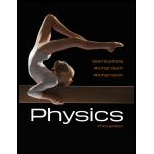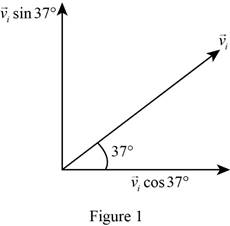
Concept explainers
(a)
The maximum height above the ground reached by the cannonball.
(a)
Answer to Problem 61P
The maximum height above the ground reached by the cannonball is
Explanation of Solution
Take the

Write the equation of motion.
Here,
When the cannon ball reaches maximum height, its velocity will be zero.
Write the equation for
Here,
The acceleration of the ball will be the negative of acceleration due to gravity.
Write the equation for
Here,
Put equations (II) to (V) in equation (I) and rewrite it for
Conclusion:
Given that the initial height of the cannonball is
The value of acceleration due to gravity is
Substitute
Therefore, the maximum height above the ground reached by the cannonball is
(b)
The horizontal distance from the release point at which the cannonball will land if it makes it over the castle walls and lands back down on the ground.
(b)
Answer to Problem 61P
The horizontal distance from the release point at which the cannonball will land if it makes it over the castle walls and lands back down on the ground is
Explanation of Solution
Write the equation of motion in
Here,
Write the equation for the horizontal distance at which the cannonball lands.
Here,
Rewrite the above equation for
Refer to figure 1 and write the equation for
Put equation (IX) in equation (VIII).
Put equations (III), (IV) and (X) in equation (VII).
Solve the above quadratic formula in
Conclusion:
When the cannonball reaches the ground the value of
Substitute
The catapult does not fire backward. This means
Therefore, the horizontal distance from the release point at which the cannonball will land if it makes it over the castle walls and lands back down on the ground is
(c)
The
(c)
Answer to Problem 61P
The
Explanation of Solution
The
Here,
Put equation (IX) in the above equation.
Rewrite equation (I) for
Put equations (III) and (IV) in the above equation and rewrite it for
Conclusion:
Substitute
Substitute
The negative sign indicates the velocity is downward.
Therefore, the
Want to see more full solutions like this?
Chapter 3 Solutions
Student Solutions Manual for Physics
 College PhysicsPhysicsISBN:9781305952300Author:Raymond A. Serway, Chris VuillePublisher:Cengage Learning
College PhysicsPhysicsISBN:9781305952300Author:Raymond A. Serway, Chris VuillePublisher:Cengage Learning University Physics (14th Edition)PhysicsISBN:9780133969290Author:Hugh D. Young, Roger A. FreedmanPublisher:PEARSON
University Physics (14th Edition)PhysicsISBN:9780133969290Author:Hugh D. Young, Roger A. FreedmanPublisher:PEARSON Introduction To Quantum MechanicsPhysicsISBN:9781107189638Author:Griffiths, David J., Schroeter, Darrell F.Publisher:Cambridge University Press
Introduction To Quantum MechanicsPhysicsISBN:9781107189638Author:Griffiths, David J., Schroeter, Darrell F.Publisher:Cambridge University Press Physics for Scientists and EngineersPhysicsISBN:9781337553278Author:Raymond A. Serway, John W. JewettPublisher:Cengage Learning
Physics for Scientists and EngineersPhysicsISBN:9781337553278Author:Raymond A. Serway, John W. JewettPublisher:Cengage Learning Lecture- Tutorials for Introductory AstronomyPhysicsISBN:9780321820464Author:Edward E. Prather, Tim P. Slater, Jeff P. Adams, Gina BrissendenPublisher:Addison-Wesley
Lecture- Tutorials for Introductory AstronomyPhysicsISBN:9780321820464Author:Edward E. Prather, Tim P. Slater, Jeff P. Adams, Gina BrissendenPublisher:Addison-Wesley College Physics: A Strategic Approach (4th Editio...PhysicsISBN:9780134609034Author:Randall D. Knight (Professor Emeritus), Brian Jones, Stuart FieldPublisher:PEARSON
College Physics: A Strategic Approach (4th Editio...PhysicsISBN:9780134609034Author:Randall D. Knight (Professor Emeritus), Brian Jones, Stuart FieldPublisher:PEARSON





